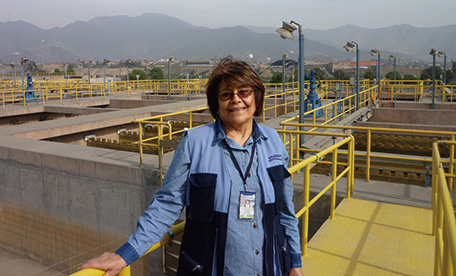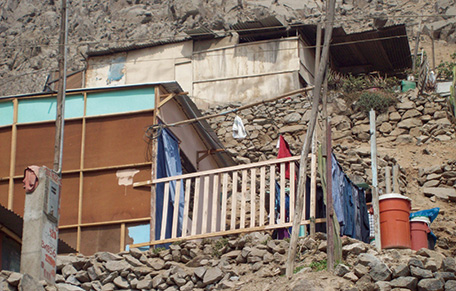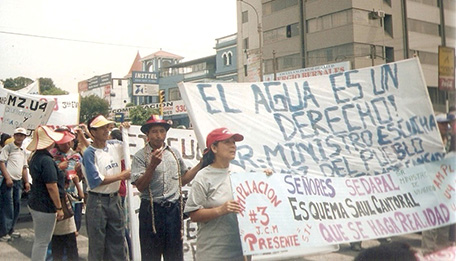Japan's Official Development Assistance White Paper 2012
Stories from the field 13
Upgrades of Water Supply and Sewerage Systems Improve Health and Lives in Lima
– ODA Loan Supports Waterworks in Peruvian Capital –

Ms. Carmela Gavonel Parales at the Huachipa Water Treatment Plant (Photo: Shusuke Matsumoto)
The population of Peru is concentrated in the dry, coastal areas and especially in the capital city of Lima, home to 30% of Peruvians with a population of 9 million people. There is not much precipitation in Lima throughout the year, and improving the supply of drinking water to the entire population is a pressing issue. People who live in areas with no water supply or sewerage systems buy water from water trucks that make the rounds, but what they buy is no more than river water with a bit of chlorine added. People who live in villages in the hills have to carry plastic tanks full of water up steep stairs, and accidents happen when they fall down. Women and children are responsible for transporting the water, and the weight of it causes some of their backs to become crooked.
Since the 1990s, the Japanese government has been providing ODA loans to support the expansion and improvement of water supply facilities run by the public waterworks company in Lima (Servicio de Agua Potable y Alcantarillado de Lima, or "SEDAPAL"). In 2000, the Lima Marginal Areas Sanitary Improvement Project began. The Huachipa Water Treatment Plant was completed in July 2011, which provides a safe, consistent water supply to 2.4 million people. Also, a water supply and sewerage system for 250,000 people in 50,000 households was built.
However, the journey to this point has not been an easy one. This ODA loan project was decided upon during the Fujimori regime (1990-2000), but proposals from post-Fujimori Peruvian administrations to privatize SEDAPAL and other events nearly wiped out the loan to build water supply and sewerage systems. "The local residents voiced their dissent," said SEDAPAL representative Carmela Gavonel Parales, who was assigned to negotiate with the people. "It was plain to see that construction would not happen in areas that would not turn a profit if waterworks were privatized. Zones connected to the water network then would see their tariffs skyrocket fivefold. People in the 18 targeted zones organized demonstrations."
Through their demonstrations, residents opposed the privatization of SEDAPAL and called for the construction of water supply and sewerage systems. Finally, the Peruvian government accepted the claims of the people by deciding to start the project.

Homes on a steep slope. Plastic buckets (right) were used to carry water prior to the construction (Photo: Regina Torme)
Before the water supply and sewerage systems were built, sewage would leak out into the streets, drying into sludge and blowing through the air in the summer and causing many people to suffer from bronchial infectious diseases. Diarrhea, typhoid, dengue fever from mosquitoes and other infectious diseases owing to the lack of a sewerage system became huge problems. The sicknesses receded dramatically after the water supply and sewerage systems were completed, which led to lower medical expenses for families and higher attendance rates at schools.
Construction of the water supply and sewerage systems changed the lives of local women in a huge way. Before the systems were built, the women would bring enormous loads of clothing to laundry areas (simple pools made of concrete) and wash together on Saturdays. They struggled to carry the laundry over long distances on foot. Now, they can do laundry any time they please, day or night. Women have been heard saying that they never knew how easy it was to do laundry at home.
The construction produced an unforeseen, fortunate benefit: residents in the relatively rainless district of San Juan de Lurigancho began growing lettuce hydroponically using tap water. They attended a seminar hosted by the Ministry of Agriculture where they learned that they could easily grow lettuce using nothing but water. The residents themselves raised the required funds, consumed and sold the lettuce they produced and used the profits to purchase water pipes and other materials and equipment.
Ms. Gabvonel noted how water supply and sewerage system construction has enabled citizens to have aspirations. "In the future, they would like to see root crops grown to help improve nutrition for children," she said. The construction of the water supply and sewerage systems accomplished through international cooperation from Japan has greatly improved the very lives of the people of Lima.

Citizens bearing a banner that says, "Water is a Right" (Photo: Regina Torme)
